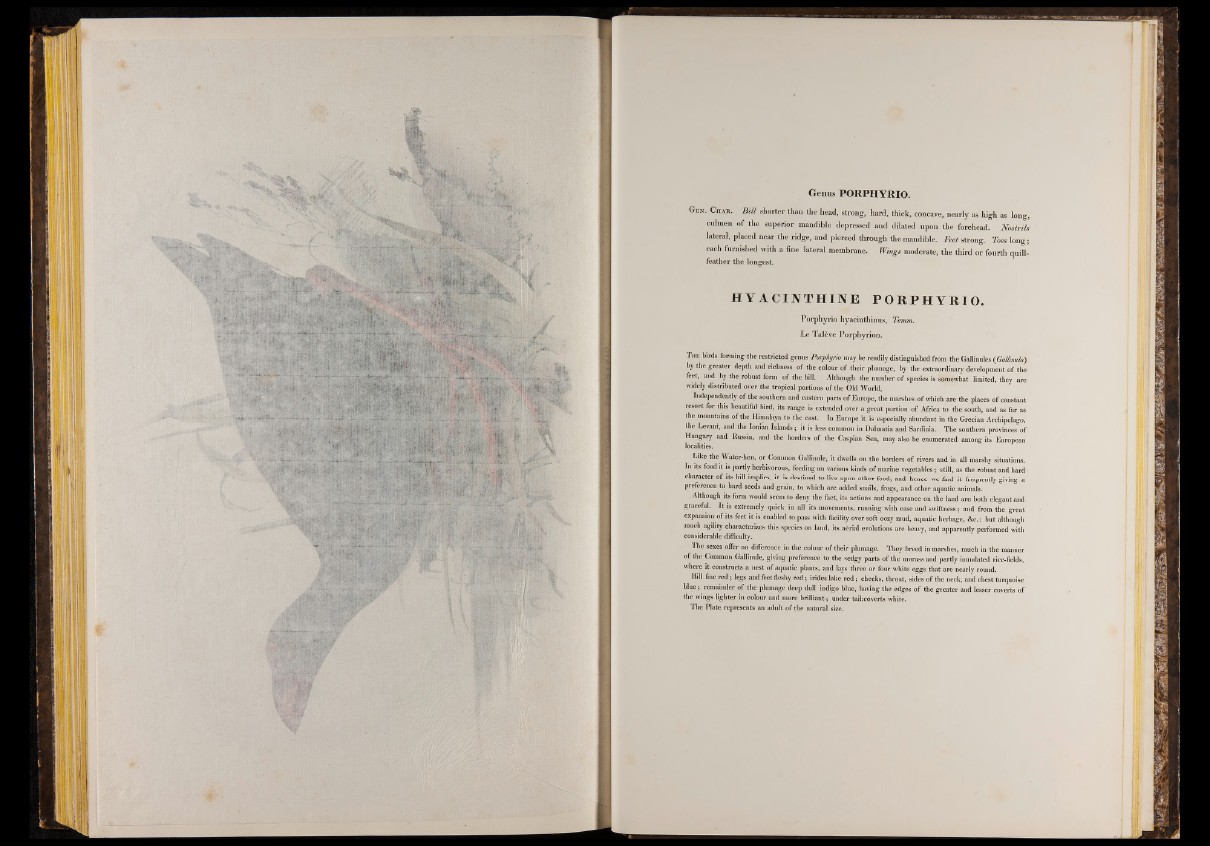
Ü
- « ¡ K »
1
j|i| ¡Rai «m jf % IJPSt 114
a
I I P lits
Ié m b P K
aü ül !i s r i
3] „ Ki ■ "i! Ì • •,
Ml
'm i
j g | | |
M
f t& M i
i s S s i l i ilsfflHlli
" è : .
g i i
l a i
»
m
H
» i r i f •
r ' U f l n
ìàlMJÌBi [Mjii ;.a
I p p l i
_
s i i ? 1
HR
w i f i ®
Genus PORPHYRIO.
G e s . Char. B i l l shorter than the head, strong, hard, thick, concave, nearly as high as long,
culmen of the superior mandible depressed and dilated upon the forehead. N o s tr ils
lateral, placed near the ridge, and pierced through the mandible. F e e t strong. Toes long ;
each furnished with a fine lateral membrane, W ings moderate, the third or fourth quill-
feather the longest.
HY A C INTHINE PORPHYRIO .
P o rp h y r io h ya cinthinus, Temm.
L e T a le v e P o rp h y r io n .
The birds forming the restricted genus Porphyrio may be readily distinguished from the Gallinules ( Gallinula)
by the greater depth and richness o f the colour o f their plumage, by the extraordinary development o f the
feet, and by the robust form o f the bill. Although the number o f species is somewhat limited, they are
widely distributed over the tropical portions o f the Old World,
Independently o f the southern and eastern parts o f Europe, the marshes o f which are the places o f constant
resort for this beautiful bird, its range is extended over a great portion of Africa to the south, and as far as
the mountains o f the Himalaya to the east. In Europe it is especially abundant in the Grecian Archipelago,
the Levant, and the Ionian Islands; it is less common in Dalmatia and Sardinia. The southern provinces o f
Hungary and Russia, and the borders of the Caspian Sea, may also be enumerated among its European
localities.
Like the' Water-hen, or Common Gallinule, it dwells on the borders o f rivers and in all marshy situations.
its food it is partly herbivorous, feeding on various kinds o f marine vegetables; still, as the robust and hard
character o f its bill implies, it is destined to live upon other food, and hence we find it frequently giving a
preference to hard seeds and grain, to which are added snails, frogs, and other aquatic animals.
Although its form would seem to deny the fact, its actions and appearance on the land are both elegant and
graceful. It is extremely quick in all its movements, running with ease and swiftness; and from the great
expansion o f its feet it is enabled to pass with facility over soft oozy mud, aquatic herbage, &c.: but although
much agility characterizes this species on land, its aerial evolutions are heavy, and apparently performed with
considerable difficulty.
The sexes offer no difference in the colour o f their plumage. They breed in marshes, much in the manner
o f the Common Gallinule, giving preference to the sedgy parts o f the morass and partly inundated rice-fields,
where it constructs a nest o f aquatic plants, and lays three or four white eggs that are nearly round.
Bill fine red ; legs and feet fleshy red ; irides lake red; cheeks, throat, sides o f the neck, and chest turquoise
blue; remainder o f the plumage deep dull indigo blue, having the edges o f the greater and lesser coverts of
the wings lighter in colour and more brilliant; under tailrcoverts white.
The Plate represents an adult o f the natural size.